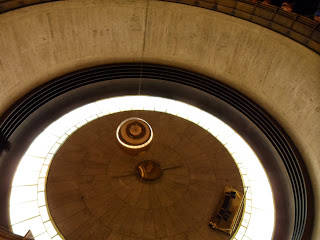Nicolaus Copernicus is the first individual who came up with the idea and drew a scientifically accurate image of the solar system. By combining the knowledge of art, math and astronomy, he demonstrated that the sun is in the center of the solar system. Copernicus's theory has had a long-lasting influence to people's lives nowadays; it is the foundation of astronomy and space science. ( Figure 1, 2)
In the 17th century, telescope was invented and it launched a new era in the discoveries of our universe. Such invention allows people to observe the universe from a completely new perspective. (Figure 3)
From a scientific analysis, human gained a deeper understanding of micro and macro, we discovered that nanotechnology also plays role in space exploration. Budbury buckyballs was discovered in the process. The buckyballs hold the helium and deliver the molecules to the surface of the earth. Recently, NASA Spitzer Space Telescope further proved the solidify form of existence of buckyballs in space. (Figure 4, 5)
The discovery of space inspired humans to explore the unknown. Such desire pushes us to constantly make progress in mathematics, nanotechnology, biotechnology and robotics. Our discovery in the process also inspired artist to create amazing artworks. Space, therefore, links all aspects of art and science together and motivate us to continue to expand our horizon.
1. Vesna , Victoria, dir. Space Intro. 2012. Film. 30 Nov 2013. <https://www.youtube.com/watch?feature=player_embedded&v=zzN08A6UBoo#t=0>
2. Vesna , Victoria, dir. Space Part 2. 2012. Film. 30 Nov 2013. https://www.youtube.com/watch?v=hLZMDpoP-u0#t=452
3. "The Space Race." History.com. A&E Television Networks, n.d. Web. 24 Nov. 2013.
4. "Space and Art." - NASA Watch. N.p., n.d. Web. 25 Nov. 2013.
5. "Wallcoo.net." Space Art : Space and Astronomical Art : Galaxies, Stars & Nebulae 1280x1024 NO.6 Desktop Wallpaper. N.p., n.d. Web. 25 Nov. 2013.






























